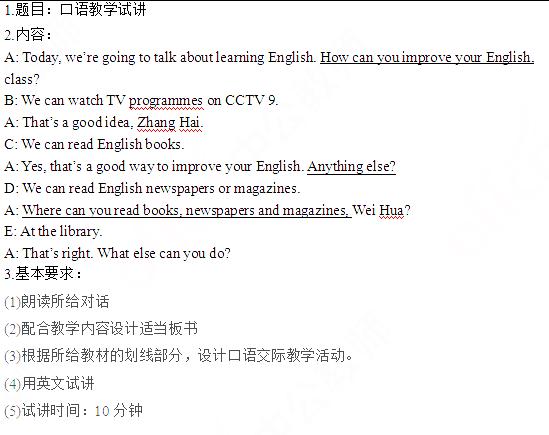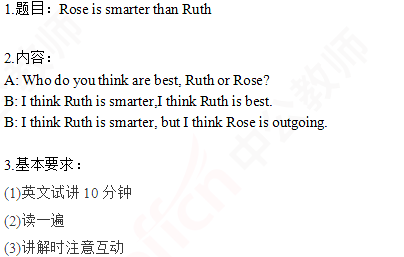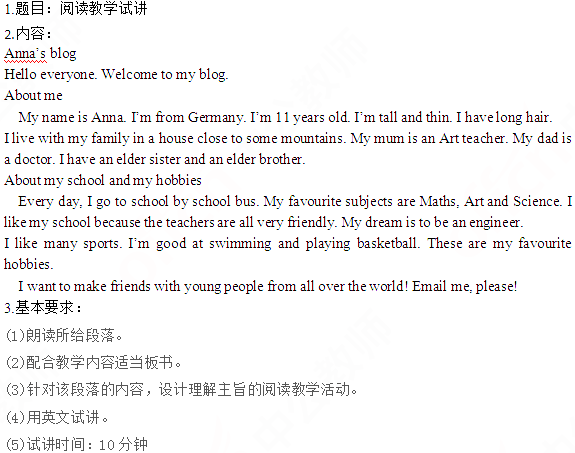
ЎЎЎЎЎҫҪМ°ёЎҝ
ЎЎЎЎTeaching aims:
ЎЎЎЎKnowledge aim:
ЎЎЎЎStudents will grasp the target expressions about asking questions, and also get some ways of learning English.
ЎЎЎЎAbility aim:
ЎЎЎЎStudents can express their opinion on learning English.
ЎЎЎЎEmotional aim:
ЎЎЎЎStudents can foster the interest and desire of learning English, and be fond of taking part in kinds of class activities.
ЎЎЎЎKey and difficult point:
ЎЎЎЎKey Point: Students can master the usage of key structures.
ЎЎЎЎDifficult Point: Students can improve their confidence in learning English, and not be afraid of speaking English.
ЎЎЎЎTeaching procedure:
ЎЎЎЎStep 1: Warming-up
ЎЎЎЎ1. Greetings.
ЎЎЎЎ2. Show a video about an English speech Ў° I Have a DreamЎұ addressed by Martin Luther King. And ask students what their feelings are.
ЎЎЎЎAnd then ask them a question: Ў°why does he speak English well?Ўұ Ў°Because he masters some skills about learning EnglishЎұ. Actually today our topic is also about this and then lead in the topic: letЎҜs speak.
ЎЎЎЎStep 2: Pre-speaking
ЎЎЎЎ1. Teacher reads the passage and asks students figure out the main idea of the dialogue.
ЎЎЎЎ2. Ask students to read the passage again and pay attention to the underlined parts. They need to answer the questions about underlined parts.
ЎЎЎЎQuestion1:How can you improve your English?
ЎЎЎЎAnswer1:watch TV programmes on CCTV9; read English books; read English newspapers and magazines.
ЎЎЎЎQuestion2:Where can you read books, newspapers or magazines?
ЎЎЎЎAnswer2:At the library.
ЎЎЎЎ3. Ask students to work in groups of four to think of other ways to improve English in 10 minutes, and then invite some groups to show their results.
ЎЎЎЎWays: Listen to English songs, watch the English movies, watch BBC documentaries.
ЎЎЎЎStep 3: While-speaking
ЎЎЎЎ1. Give the whole class 5 minutes to make dialogues with their desk mates. They are suppose to use the information on the blackboard.
ЎЎЎЎ2. During this period, the teacher will walk around and give the evaluation to encourage students to open their mouth and speak English loudly.
ЎЎЎЎStep4: Post-speaking
ЎЎЎЎAfter that, the teacher invites some of groups to come to the stage to show their performance in the front of the whole class. Teacher gives evaluation and encouragement. Emphasize the importance of learning English.
ЎЎЎЎStep5: Summary and Homework
ЎЎЎЎSummary: summarize with the whole class.
ЎЎЎЎHomework: ask students to choose their favorite ways to practice English and make a daily plan for their English study.
ЎЎЎЎBlackboard design:ВФ

ЎЎЎЎЎҫҪМ°ёЎҝ
ЎЎЎЎTeaching aims:
ЎЎЎЎKnowledge aims:
ЎЎЎЎStudents can master the usage of comparative adjectives
ЎЎЎЎAfter this lesson, students can use the sentence structure: Ў°Rose is smarter than RuthЎұ.
ЎЎЎЎAbility aim:
ЎЎЎЎAfter this lesson, students can use this grammar to describe the things in their daily life
ЎЎЎЎEmotional aim:
ЎЎЎЎStudents are able to get the confidence of learning English
ЎЎЎЎKey and difficult point:
ЎЎЎЎKey Point:
ЎЎЎЎmaster the usage of the comparative form of an adjective
ЎЎЎЎDifficult Point:
ЎЎЎЎuse this grammar to describe the things in their daily life.
ЎЎЎЎTeaching procedures:
ЎЎЎЎStep 1: Warming-up
ЎЎЎЎ1.Greeting
ЎЎЎЎ2.Free talk:The teacher talks about the experience in zoo.Let students describe the features of animals in the zoo.
ЎЎЎЎ3.Then write one sentence and ask students to fill it using the right words. Then lead in the topic of today:Rose is smarter
ЎЎЎЎElephant is_____(big/small).
ЎЎЎЎSquirrel is _____(big/small)
ЎЎЎЎStep 2: Presentation
ЎЎЎЎ1.play a tap and ask them some question
ЎЎЎЎQ1:whatЎҜs the feature of Rose and Ruth?
ЎЎЎЎRose is smarter than Ruth.
ЎЎЎЎQ2:whatЎҜs the characteristic of Ruth and Rose ?
ЎЎЎЎRuth is more outgoing than Rose.
ЎЎЎЎAnd then underline the adjective, ask a question :what are the similarities between the sentences and the adjectives.
ЎЎЎЎAfter that conclude the usage of the comparative degree.
ЎЎЎЎStep 3: Practice
ЎЎЎЎ1.Do the guessing game. Ask students to guess the words that the teacher is acting.
ЎЎЎЎ2.Write some sentences on the blackboard and ask students to fill in the blank using the comparative degree form of adjective.
ЎЎЎЎStep4: Production
ЎЎЎЎShow two similar pictures for students and then ask them to describe the differences of the two pictures, when they describe the pictures they should use the comparative degree.5 minutes for them to discuss with their desk mates and later ask some of them to share their ideas.
ЎЎЎЎStep 5: Summary and Homework
ЎЎЎЎSummary: ask a student to conclude the content of the lesson and summarize the class.
ЎЎЎЎHomework: ask students make more sentences using the grammar they learn today.
ЎЎЎЎBlackboard design:ВФ

ЎЎЎЎЎҫҪМ°ёЎҝ
ЎЎЎЎTeaching aims:
ЎЎЎЎKnowledge aim:
ЎЎЎЎStudents can get the main idea of the passage quickly.
ЎЎЎЎAbility aim:
ЎЎЎЎStudents will improve their reading abilities such as skimming and scanning.
ЎЎЎЎEmotional aim:
ЎЎЎЎStudents will be more interested in learning English.
ЎЎЎЎKey and difficult point:
ЎЎЎЎKey Point: Students will know how to get the main idea of the passage.
ЎЎЎЎDifficult Point: Students will be more confident in speaking English and improve their reading skills.
ЎЎЎЎTeaching procedure:
ЎЎЎЎStep 1: Warming-up
ЎЎЎЎ1. Greetings.
ЎЎЎЎ2..Show a picture to students and then ask them a question :what can you see from the picture?
ЎЎЎЎSome of the students may figure out it is a blog and ask some of them:Do you write blogs and know their feelings of blogs?
ЎЎЎЎStep 2: Pre-reading
ЎЎЎЎShow the title of the passage and ask students to predict whatЎҜs the main idea of the passage.
ЎЎЎЎStep 3: While-reading
ЎЎЎЎ1st listening: Ask students to listen to the tape for the first time and check if their prediction is correct or not and get the main idea of the passage.
ЎЎЎЎ2nd listening: Ask students to listen to the tape for the second time and complete the card about Anna below:
ЎЎЎЎStep4: Post-reading
ЎЎЎЎAsk students to talk about the information of their best friend with the items on the blackboard. Four students in a group and give them five minutes.
ЎЎЎЎStep 5: Summary and Homework
ЎЎЎЎSummary: ask a student to conclude the content of the lesson and summarize with the whole class.
ЎЎЎЎHomework: ask students to write their own blog and introduce themselves.
ЎЎЎЎBlackboard design:ВФ
ИЛБҰЩYФҙҝјФҮҪМҺҹЩYёсҝјФҮіц°жҢЈҳI(yЁЁ)ЩYёсҪЎҝө№ЬАнҺҹҢ§(dЁЈo)УОҝјФҮЙз•ю№ӨЧчХЯЛҫ·ЁҝјФҮВҡ·QУӢЛгҷC(jЁ©) IрB(yЁЈng)ҺҹРДАнЧЙФғҺҹУэӢлҺҹКВҳI(yЁЁ)ҶОО»ҪМҺҹХРЖё№«„Х(wЁҙ)ҶT№«ЯxҝјФҮХРҫҜҝјФҮЯxХ{(diЁӨo)Йъҙе№Щ
іхјү•юУӢВҡ·QЦРјү•юУӢВҡ·QҪӣ(jЁ©ng)қъ(jЁ¬)ҺҹЧўғФ•юУӢҺҹЧCИҜҸДҳI(yЁЁ)гyРРҸДҳI(yЁЁ)•юУӢҢҚІЩҪy(tЁҜng)УӢҺҹҢҸУӢҺҹёЯјү•юУӢҺҹ»щҪрҸДҳI(yЁЁ)ЩYёс¶җ„Х(wЁҙ)ҺҹЩY®a(chЁЈn)Фu№АҺҹҮшлHғИ(nЁЁi)ҢҸҺҹACCA/CATғrёсиbЧCҺҹҪy(tЁҜng)УӢЩYёсҸДҳI(yЁЁ)
Т»јүҪЁФмҺҹ¶юјүҪЁФмҺҹПы·А№ӨіМҺҹФмғr№ӨіМҺҹНБҪЁВҡ·Q№«В·ҷzңy№ӨіМҺҹҪЁЦю°ЛҙуҶTЧўғФҪЁЦюҺҹ¶юјүФмғrҺҹұO(jiЁЎn)Ан№ӨіМҺҹЧЙФғ№ӨіМҺҹ·ҝөШ®a(chЁЈn)№АғrҺҹ іЗаl(xiЁЎng)ТҺ(guЁ©)„қҺҹҪY(jiЁҰ)ҳӢ(gЁ°u)№ӨіМҺҹҺrНБ№ӨіМҺҹ°ІИ«№ӨіМҺҹФO(shЁЁ)ӮдұO(jiЁЎn)АнҺҹӯh(huЁўn)ҫіУ°н‘ФuғrНБөШөЗУӣҙъАн№«В·ФмғrҺҹ№«В·ұO(jiЁЎn)АнҺҹ»Ҝ№Ө№ӨіМҺҹЕҜНЁ№ӨіМҺҹҪoЕЕЛ®№ӨіМҺҹУӢБҝ№ӨіМҺҹ
ҲМ(zhЁӘ)ҳI(yЁЁ)ЛҺҺҹҲМ(zhЁӘ)ҳI(yЁЁ)бt(yЁ©)ҺҹРl(wЁЁi)ЙъЩYёсҝјФҮРl(wЁЁi)ЙъёЯјүВҡ·QЧo(hЁҙ)КҝЩYёсЧCіхјүЧo(hЁҙ)ҺҹЦч№ЬЧo(hЁҙ)ҺҹЧЎФәбt(yЁ©)ҺҹЕRҙІҲМ(zhЁӘ)ҳI(yЁЁ)бt(yЁ©)ҺҹЕRҙІЦъАнбt(yЁ©)ҺҹЦРбt(yЁ©)ҲМ(zhЁӘ)ҳI(yЁЁ)бt(yЁ©)ҺҹЦРбt(yЁ©)ЦъАнбt(yЁ©)ҺҹЦРОчбt(yЁ©)бt(yЁ©)ҺҹЦРОчбt(yЁ©)ЦъАнҝЪЗ»ҲМ(zhЁӘ)ҳI(yЁЁ)бt(yЁ©)ҺҹҝЪЗ»ЦъАнбt(yЁ©)Һҹ№«№ІРl(wЁЁi)Йъбt(yЁ©)Һҹ№«Рl(wЁЁi)ЦъАнбt(yЁ©)ҺҹҢҚЫ`јјДЬғИ(nЁЁi)ҝЖЦчЦОбt(yЁ©)ҺҹНвҝЖЦчЦОбt(yЁ©)ҺҹЦРбt(yЁ©)ғИ(nЁЁi)ҝЖЦчЦОғәҝЖЦчЦОбt(yЁ©)ҺҹӢD®a(chЁЈn)ҝЖбt(yЁ©)ҺҹОчЛҺКҝ/ҺҹЦРЛҺКҝ/ҺҹЕRҙІҷzтһјјҺҹЕRҙІбt(yЁ©)ҢW(xuЁҰ)АнХ“ЦРбt(yЁ©)АнХ“